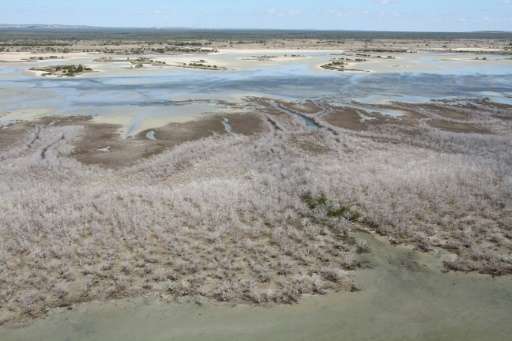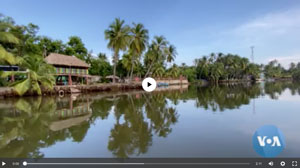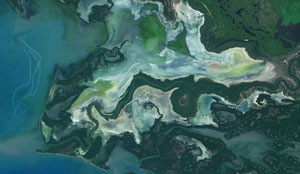FEATURED STORY
Moon’s ‘wobbles’ mysteriously linked to mass mangrove tree deaths in Australia  AUSTRALIA – A wobble in the moon’s orbit around Earth affects mangrove cover across Australia and likely contributed to mass tree deaths in the Gulf of Carpentaria, new research suggests. A study published in the journal Science Advances has found that an 18.61-year cycle known as the lunar nodal cycle shapes the condition of tidal wetlands. The moon’s orbit around Earth does not occur in a flat plane. “Since the 1720s, people have known that it moves up and down by a few degrees,” said the study’s lead author, Prof Neil Saintilan of Macquarie University. He likened the motion to “when you’re spinning a coin – as it loses momentum, it kind of wobbles”. Changes in gravitational pull as a result of this lunar wobble are known to affect the Earth’s tides. Previous research conducted by Nasa scientists has predicted that in the mid-2030s, the lunar wobble will amplify rising sea levels caused by climate change, resulting in high-tide floods along coastlines. Depending on the phase of the lunar nodal cycle, there can be “as much as 40cm of difference in the tide range” in places such as the Gulf of Carpentaria, Saintilan said. READ MORE AFRICA Call for increased push to halt deforestation and enhance restoration

DRC – Concrete action is needed to halt ‘alarming trends’ of deforestation and forest degradation in Africa, the 23rd Session of the African Forestry and Wildlife Commission (AFWC) heard last week in Kinshasa. Participants from 53 countries took part in the meeting under the theme “The role of forests and wildlife in building resilience and recovery from crises and threats”. Established by the Food and Agriculture Organization of the United Nations (FAO), the AFWC provides one of the region’s most important inter-governmental forums for discussion of issues relating to forestry and wildlife on the continent. Attendees heard Africa hosts 16 percent of the world’s forests and that deforestation rates in the region have slowed by 23 percent from 2000 to 2018. However, when rates of deforestation and forest expansion are considered, the average annual rate of net forest loss in Africa rose to 3.9 million hectares from 2010 to 2020, the region’s highest net loss of forest area in three decades. In particular, cropland expansion but also the conversion of forests to grassland were cited as the main drivers of forest losses in the region. READ MORE With forests abound, Africa looks to grow its carbon market

KENYA – In villages dotted across the African continent, locals living in once-heavily forested regions are starting to find their land in high demand. In Kenya’s Gazi Bay, arguably the continent’s most famous mangrove restoration project, thousands of trees have been planted thanks to nearly a decade of concerted efforts to offset carbon dioxide released by faraway governments and companies seeking to improve their climate credentials. The initiative was one of Africa’s first steps into the carbon market, where credits to emit greenhouse gases can be bought or sold. Since then, dozens of similar schemes have sprouted across the continent, with African governments now looking to capitalize on this exploding global industry. The continent is home to huge swaths of carbon-absorbing lands, with forest covering roughly 674 million hectares, or 22.7%, of Africa, according to the U.N. Food and Agriculture Organization. The Cuvette-Centrale Peatlands deep in the Congo Basin are alone capable of locking in up to 30 billion tons of carbon, or three years worth of the world’s emissions. Waterside mangrove forests, which are more effective at sucking carbon out of the air than their land counterparts, have swelled in places like Gazi. READ MORE AMERICAS Researchers study how to best support Florida mangrove, coral reef ecosystems

USA – At a time when developers are cutting down mangroves and building in such a way that’s harming coral reefs, scientists will work with community members on solutions and policy changes. A team of researchers led by the University of South Florida is getting $20 million from the National Science Foundation to develop solutions to protect and replenish coral reef and mangrove ecosystems. Coral reefs and mangroves safeguard our coasts by reducing flooding, erosion and wave intensity during storms. They also provide habitat for marine life. Mangroves serve as fish nurseries, and coral reefs help fish hideout, as well. So, in terms of the benefit to biodiversity, these are two really important ecosystems. But mangroves are removed for development and coral reefs are threatened by pollution and rising temperatures. Now, USF is collaborating with University of Miami, Boston University, Stanford University, University of California Santa Cruz, University of Virgin Islands and East Carolina University to combine natural features with artificial infrastructure to help these ecosystems thrive. The scientists will look into hybrid models for coral reef and mangrove restoration, such as using concrete or cement to assist in mangrove planting so that they are protected and able to grow. READ MORE ASIA Sinking villages look to nature to help Indonesia restore mangroves

INDONESIA – In a coastal community on Indonesia’s Java island, villagers must constantly take soil and stones to local graveyards to secure the resting places of their dead friends and relatives – fearful that frequent flooding will sweep away the deceased. Like other flood-prone villages in the northern Demak regency, Timbulsloko’s problems are threefold – with over-extraction of groundwater causing sinking, aquaculture contributing to some of the worst coastal erosion across the archipelago, and sea levels rising due to climate change. The more than 3,000 people in Timbulsloko, who refuse to abandon their homes, often pay for trucks to transport dirt and rocks from nearby mountainous areas in order to protect graves, and to elevate their houses above the rising waters. “Since 2008, there is more flooding because of coastal erosion,” said fisherman Suratno, who like many Indonesians goes by one name, sitting on the floor of his one-storey house, where the front door was blocked by ankle-deep flood waters. “Every day there is flooding – the morning, afternoon or at night,” the 51-year-old told the Thomson Reuters Foundation last month. READ MORE Restoring Myanmar’s Mangroves

MYANMAR – Myanmar is believed to be experiencing one of the highest rates of mangrove loss in the world. When a company bought land containing a mangrove forest in the country’s Tanintharyi region, with plans to convert it into prawn farms, the local community fought back. The villagers had previously been unable to stop the purchase of an initial tranche of land, but when the company returned in an attempt to buy another 283 hectares of mangrove, locals were prepared; they had received a Securing Community Forest certificate, which served as a bulwark against further deforestation. A local non-profit organization, Green Network Tanintharyi Region (GNTR) has so far helped 20 villages receive certification. READ MORE Indonesia may lose 26,100 ha mangrove area per year

INDONEIA – Indonesia could lose 26,100 hectares of mangroves per year due to land conversion arising from the development of infrastructure, aquaculture, and illegal logging, the Peatland and Mangrove Restoration Agency (BRGM) has cautioned. Deforestation and conversion of the mangrove ecosystem would release carbon stored underground and impact the climate targets stated in Indonesia’s nationally determined contributions (NDC) document, BRGM secretary Ayu Dewi Utari said at the “The Climate Corner” discussion, which was followed online from here on Wednesday. The mangrove ecosystem has the potential to store a large amount of carbon and the conversion of the ecosystem can release carbon stocks underground, she added. “According to a study, with the existing mangrove area of 3.36 million hectares, based on the 2021 National Mangrove Map, plus the potential of 752 thousand hectares of mangrove ecosystem, Indonesia’s mangrove ecosystem is estimated to store carbon reserves of up to 3,638 megatons of CO2,” she elaborated. READ MORE FEATURED VIDEOS Climate Change Stresses El Salvador’s Mangrove Forests

EL SALVADOR – In El Salvador, climate change is stressing the country’s mangrove forests. Some coastal communities are working with nongovernmental organizations to save these important areas that protect the coastline. For VOA News, Claudia Zaldaña visited the area and has the report. Video editor: Cristina Caicedo Smit WATCH VIDEO Thousands of volunteers come out for International Coastal Cleanup Day

USA – More than 22,000 lbs. of trash were picked up from our South Florida shorelines, streets and waterways in just one day, but all of that is unfortunately just a drop in the bucket. WATCH VIDEO
Like this newsletter?
 Pease consider donating to MAP to keep it going.
Giving could never be easier  *Articles in this newsletter may mention practices being used and/or show exagerated results being claimed without proof. Stories are presented here in effort to show mangrove related activity around the world and do not necessarily reflect Mangrove Action Project’s views or mangrove restoration best-practices. | NOTICE
Mangrove Macrobenthos Managament Conference MMM6 Colombia 2023
On behalf of the Organizing Committee of the MMM6, we want to announce that MMM6 organizers are working to hold the conference in the last week of July 2023 in Cartagena de Indias. We hope to make the official launch very soon. We invite you to follow them on twitter @MeetingMmm6
ACTION ALERTS Do not sacrifice Congo’s rainforests to the oil industry! TAKE ACTION TAKE MAP SURVEY Please see the survey questionnaire we at MAP put together to discover where the shrimp industry is still having major adverse effects on mangroves and local communities.
TAKE THE SURVEY Stop the Dredging – 6.7 million cubic meters of sand from the Addu atoll basin will destroy nature, biodiversity and the natural defences and resilience of this UNESCO Biosphere Reserve. SIGN THE PETITION Keep fossil fuels out of Bangladesh for the health and wellbeing of the local communities, the beautiful regional beaches and forests, the Bangladeshi economy, and our shared climate. SIGN PETITION Stop this total madness Stop the biggest heated oil pipeline in the world — right through the heart of Africa!
CLICK HERE
Like this newsletter? Pease consider donating to MAP to keep it going. Giving could never be easier 
MAP Website en Español
haga clic aqui 13 Year old Linda Li “Mangrove Adventure” from Kid Dream Art School

WATCH NOW 
Restoring The Natural Mangrove Forest
Watch movie

Community Based Ecological Mangrove Restoration in Rufiji Delta VIEW VIDEO
Video: Mangroves for the Future
View Here WANT TO GET INVOLVED?
Follow and Join MAP!    
Like this newsletter? Pease consider donating to MAP to keep it going. Giving could never be easier 

Interested in connecting or working with MAP? Check out our opportunities here 
MANGROVE ISSUES Want to learn more about mangroves?
Our short presentation will give you a better understanding of the issues we are working to solve. WATCH PRESENTATION What is CBEMR? Download MAP’s 2 page CBEMR Information Sheet containing links to all MAP’s CBEMR resources – CLICK HERE View MAP’s uploaded Videos at
MAP Video Gallery Question Your Shrimp Consumer/Markets Campaign!
WATCH VIDEO Mangroves: Guidebook to Malaysia – Click Here SHARE MAP’S VISION
CLICK HERE to watch short introductory video. Together we can work “at the roots of the sea”. Our short documentary, Reducing the Risk of Disaster through Nature-Based Solutions : Mangroves 
NASA Study Maps the Roots of Global Mangrove Loss

Marvellous Mangroves Curriculum The Marvellous Mangroves Curriculum begins with a simple philosophy – getting future generations to not only learn about, but understand the importance of mangrove forests. VISIT 
The award-winning Marvellous Mangroves (MM) curriculum educates children on the importance of mangroves and their ecological functions, teaching them about modern challenges and mechanisms for sustainability. VIEW VIDEO Marvellous Mangroves Curriculum in Bangladesh – WATCH VIDEO
MARVELLOUS MANGROVES IN BRAZIL
En Portuges 
Marvellous Mangroves – A Curriculum-Based Teachers Guide.
Like this newsletter? Pease consider donating to MAP to keep it going. Giving could never be easier 
“Question Your Shrimp” Campaign Question Your Shrimp – is it really sustainable? Sign the Petition
Note to Our Readers: We strive to keep active links in our newsletter. However, due to circumstances beyond our control, occasionally links to stories may become broken. If you find a link to a story is not functioning, please cut and paste the headline into your browser search bar. In most cases you should be able to locate the original story.
Not yet a MAP News subscriber?
Click here to subscribe. 
*Articles in this newsletter may mention practices being used and/or show exagerated results being claimed without proof. Stories are presented here in effort to show mangrove related activity around the world and do not necessarily reflect Mangrove Action Project’s views or mangrove restoration best-practices.
|

























